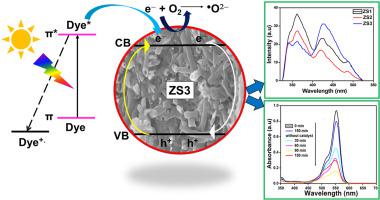当前位置:
X-MOL 学术
›
J. Alloys Compd.
›
论文详情
Our official English website, www.x-mol.net, welcomes your
feedback! (Note: you will need to create a separate account there.)
pBiomolecule assisted morphology-controllable synthesis of Zinc Sulphide nanomaterials for efficient photocatalytic activity under solar irradiation
Journal of Alloys and Compounds ( IF 5.8 ) Pub Date : 2020-12-01 , DOI: 10.1016/j.jallcom.2020.155810 Dhrubajyoti Samanta , Parita Basnet , T. Inakhunbi Chanu , Somenath Chatterjee
Journal of Alloys and Compounds ( IF 5.8 ) Pub Date : 2020-12-01 , DOI: 10.1016/j.jallcom.2020.155810 Dhrubajyoti Samanta , Parita Basnet , T. Inakhunbi Chanu , Somenath Chatterjee

|
Abstract Tuning the optical and morphological properties of Zinc Sulphide (ZnS) nanomaterials (NMs) may be executed based on its synthetic approaches with experimental parameters that may improve the photocatalytic degradation efficiency as compared to bulk ZnS. A bio-molecule (Citrus limetta juice) assisted synthetic method was employed with the variation of precursors and stabilizer ratio for manipulating the morphology of as-synthesized ZnS NMs. Field emission scanning electron microscopic analysis confirmed the structure of nanospheres/nanoflowers/nanotubes of ZnS NMs, corresponding to different sulphur ratios and amount of Citrus limetta juice-extract. Chemical composition of the ZnS NMs was substantiated by X-ray photoelectron spectroscopy. The photocatalytic degradation ability of the ZnS NMs toward major water pollutants: Rhodamine B and Methyl orange, indicated the correlation between morphological and photocatalytic properties. Highest defect emission due to Sulphur interstices and lowest band edge emission due to less electron-hole pair recombination, as-observed through Photoluminescence spectroscopy, accounted for maximum degradation of dyes by ZnS nanospheres as compared to nanoflowers/nanotubes, which may be attributed to the high separation efficiency of electron-hole pairs and high surface-to-volume ratio. Electrochemical impedance spectroscopy established the highest electrical conductivity of ZnS nanospheres. 85% degradation of RhB and 82% degradation of MO under sunlight were achieved with ZnS nanospheres. Reusability and radical scavenging studies revealed reduction of ∼10% degradation efficiency after 3rd cycle and super oxide radical ions as the prominent reactive species during degradation processes, respectively.
中文翻译:

pBiomolecule 辅助形态可控合成硫化锌纳米材料在太阳照射下具有高效的光催化活性
摘要 硫化锌 (ZnS) 纳米材料 (NMs) 的光学和形态特性可以基于其合成方法和实验参数进行调整,与块状 ZnS 相比,可以提高光催化降解效率。采用生物分子(柑橘汁)辅助合成方法,通过改变前体和稳定剂比例来操纵合成的 ZnS NMs 的形态。场发射扫描电子显微镜分析证实了 ZnS NMs 的纳米球/纳米花/纳米管的结构,对应于不同的硫比和柑橘汁提取物的量。X 射线光电子能谱证实了 ZnS NMs 的化学成分。ZnS NMs对主要水污染物的光催化降解能力:罗丹明 B 和甲基橙表明了形态和光催化性能之间的相关性。通过光致发光光谱观察,由于硫间隙导致的最高缺陷发射和由于较少的电子-空穴对复合导致的最低带边缘发射,与纳米花/纳米管相比,ZnS 纳米球对染料的降解最大,这可能归因于电子-空穴对分离效率高,表面体积比高。电化学阻抗谱确定了硫化锌纳米球的最高电导率。使用 ZnS 纳米球实现了在阳光下 85% 的 RhB 降解和 82% 的 MO 降解。
更新日期:2020-12-01
中文翻译:

pBiomolecule 辅助形态可控合成硫化锌纳米材料在太阳照射下具有高效的光催化活性
摘要 硫化锌 (ZnS) 纳米材料 (NMs) 的光学和形态特性可以基于其合成方法和实验参数进行调整,与块状 ZnS 相比,可以提高光催化降解效率。采用生物分子(柑橘汁)辅助合成方法,通过改变前体和稳定剂比例来操纵合成的 ZnS NMs 的形态。场发射扫描电子显微镜分析证实了 ZnS NMs 的纳米球/纳米花/纳米管的结构,对应于不同的硫比和柑橘汁提取物的量。X 射线光电子能谱证实了 ZnS NMs 的化学成分。ZnS NMs对主要水污染物的光催化降解能力:罗丹明 B 和甲基橙表明了形态和光催化性能之间的相关性。通过光致发光光谱观察,由于硫间隙导致的最高缺陷发射和由于较少的电子-空穴对复合导致的最低带边缘发射,与纳米花/纳米管相比,ZnS 纳米球对染料的降解最大,这可能归因于电子-空穴对分离效率高,表面体积比高。电化学阻抗谱确定了硫化锌纳米球的最高电导率。使用 ZnS 纳米球实现了在阳光下 85% 的 RhB 降解和 82% 的 MO 降解。











































 京公网安备 11010802027423号
京公网安备 11010802027423号